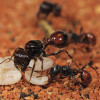We're all familiar with Pavlov's experiments with his dogs. He conditioned them to salivate at the sound of a bell, by training them to expect food. Now, more than a hundred years later, scientists at the University of Washington have discovered the nerve cells that enable us to learn from experience in this way.
The researchers have been using a cutting-edge technique, charmingly called Arc catfish, to look at individual nerve cells, or neurons, in rat brains. The cells are from a part of the brain called the amygdale, which is activated when rates are doing learning tasks, of the type used by Pavlov. These are known as associative learning tasks, and they're studied by many scientists as a good model of plasticity - that's how the brain can change and learn as a result of experience.
Writing in the journal PNAS, the researchers directly looked at the activation of nerve cells where learning was taking place. To do this, they gave the rats either a so-called conditioned stimulus, that the rats learned to dislike - in this case a saccharine solution - or an unconditioned stimulus - which was an injection that made the rats sick.
The nerve cells they looked at were quite special, in that they show what's known as convergent activation - they can process signals coming in from several different parts of the brain or body. This convergent activation is thought to be important for learning, but until now there's been little direct evidence to show that it's really involved.
Using their new imaging technique, the researchers were able to look at nerve cell activation over a 30-minute time span while the rats were undergoing learning - basically being given the saccharine solution, then the injection to make them feel ill.
The imaging technique showed that some neurons were activated by the saccharine, or the conditioned stimulus, and others were activated by the injection, the unconditioned stimulus. In addition, a very small number of neurons - about four per cent - were activated by both stimuli.
In their next experiments, the researchers switched the order of the solutions - giving the nasty injection first and the saccharine later - this is known not to lead to learning. And as you might expect, the scientists found convergent neurons were not activated.
So this shows that you need to have your convergent neurons triggered in order to do associative learning. Next, the scientists want to use their imaging technique to look at fear learning.
- Previous Malaria vaccine trials promising
- Next Another quake due










Comments
Add a comment